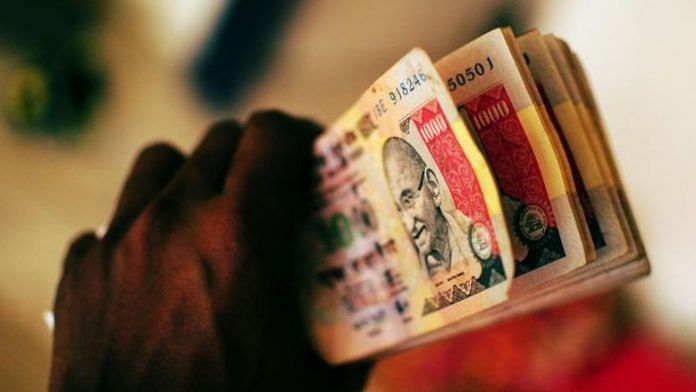New Delhi: The demonetisation exercise, initiated in November 2016, resulted in an increase in digital payments, enabled income-tax authorities to detect unaccounted income, nudged the public to be tax compliant and also had an impact on the country’s economic growth, the Centre has told the Supreme Court.
In a 16-page affidavit submitted to the top court Wednesday, the government defended the exercise – in which Rs 500 and Rs 1000 currency notes were withdrawn from circulation – saying it was part of the government’s continuous effort to eradicate black money.
“The overall impact of the withdrawal of the legal tender on the economic growth was transient, with real growth rate being 8.2 per cent in financial year 16-17 and 6.8 per cent in 17-18, both being more than the decadal growth rate of 6.6 per cent in the pre-pandemic years,” the affidavit submitted.
The government document was filed in an ongoing case challenging the demonetisation policy. A five-judge constitution bench, seized of a batch of petitions on it, is likely to hear the matter on 24 November.
After the withdrawal of the two currency notes, the affidavit stated, the volume of digital payment increased many-fold. From 1.09 lakh digital transactions of value Rs 6,952 crore in 2016, the volume shot up to more than 730 crore. Transactions worth Rs 12 lakh crore were done in a single month during October this year.
“The notification issued on 8 November, 2016 on demonetisation was a major step to fight the menace of fake currency notes, storage of unaccounted wealth and financing of subversive activities,” the affidavit stated.
This exercise followed the Supreme Court’s order in 2011, in which it had directed the government to constitute a special investigation team (SIT) to probe and examine the issue of black money.
The SIT was formed in 2014, which made several recommendations on ways to limit cash holdings and bring them into the banking system. Alongside, the government also found there was a massive increase in circulation of Rs 500 and Rs 1000 bank notes.
In its justification to withdraw the two currency notes, the affidavit further said the Reserve Bank of India (RBI) data showed a “steep rise of the two highest denominations” from 2010-11 to 2015-16. There was a 76.4 per cent increase in the circulation of Rs 500 and 109 per cent rise in Rs 1000 notes.
Meanwhile, the RBI and Indian government had also considered the introduction of a new series of notes to tackle black money, counterfeiting and illegal financing. Therefore, on the recommendation of RBI’s Central Board, the government issued the notification to withdraw notes of the two denominations.
“It was not a standalone or isolated economic policy action,” the affidavit added. Demonetisation was one of the “significant steps” taken to strengthen and expand the formal economy, dilute the informal economy and root out black money and eradicate fake currency.
It was a measure taken as part of the “reform agenda” to “transform the nation” through a series of economic policies aimed to include large sections of the informal economy to become part of the formal economy and reap its benefits.
Also read: ‘For casteless, classless society’: In EWS ruling, SC judges call for timeline to end quotas
Policy helped to integrate informal sector into financing system
Formalisation of the economy was a “policy push intended to expand opportunities” for the millions living on the periphery of the economy. This, the affidavit contended, was crucial because a major workforce in India works in the informal sector. The 2011 Census puts this figure at 400 million, out of the total workforce of 481 million.
The Centre said the workforce in the “predominantly cash-based” informal labour sector was integrated into the formal financing system through demonetisation and measures such as digitalisation, mobile and internet connectivity and opening of bank accounts. It eliminated their reliance on cash transactions, the affidavit said.
Moreover, the deposits made into bank accounts during that period enabled the income tax authorities to detect a significant amount of unaccounted income. As a result, the number of Permanent Account Number (PAN), tax returns and persons paying income tax increased significantly. Enrolment with the Employees Provident Fund Organisation (EPFO) and the Employees State Insurance Corporation has seen a much larger increase than in the past.
On the legal aspect, the declaration was made according to the “substantive power prescribed under the RBI Act”.
The law confers power on the Center to withdraw any series of banknotes of any denomination on the recommendation of the RBI. The consultation process with RBI began in February 2016, but the decision-making process was kept confidential, the affidavit said.
Also read: ‘Keeping names on hold not acceptable’ — SC questions Centre on delay in judicial appointments



